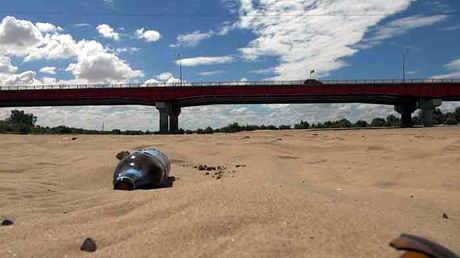
|
|

|
|
| April 16, 2024 |
|
Shrinking river threatens desert Southwest 
LAS VEGAS - The desert sun beats down from a cloudless sky as landscaper Mat Baroudi roars across Lake Mead in his motorboat.
It’s hot. The lake is the perfect place to be on a scorching Nevada morning. Baroudi loves coming out here with his son to fish and swim. But for the last few years, they have watched the lake shrink from under them. “Every time we come out here, we’re shocked by how much water’s missing,” Baroudi shouted over the roar of the engine. To get an idea how far the nation’s largest reservoir has fallen, consider this: What was once one of Lake Mead’s top scuba-diving spots is now halfway up a dry hillside. Lake Mead anchors the lower half of the river basin, a system that provides water to nearly 40 million people in seven U.S. states. Cities from San Diego to Denver drink from the Colorado. The river irrigates more than 5 million acres of farmland, including California’s Imperial Valley and Arizona’s Yuma County, two areas that supply the nation with most of its vegetables through the winter season. Both would be barren without its waters. As Lake Mead recedes, it has left a white stripe of mineral deposits 14 stories tall across the brown and red rock walls, as if to underline a question: Have we overreached? From North Africa to Southeast Asia, many of the world’s key river systems are being stretched to their limits. In a 2012 report, U.S. intelligence agencies said fresh water supplies along the Indus, Mekong, Nile, Tigris-Euphrates and other river systems will not keep up with demand in the coming decades. Food security, economic development and regional stability are all at risk, it warned. The same is true for the Colorado. The river touches nearly every aspect of life in the Southwest, said Pat Mulroy, former head of the Southern Nevada Water Authority and currently a senior fellow at the Brookings Mountain West research institution. “You have some of the largest Western cities — some of the largest American cities — that are critically dependent on this water supply,” Mulroy said. “You have some of the most productive agricultural areas…. You have some of the grandest national parks. You have any number of [Native American] tribal nations. You have an enormous hydropower production. And you have an obligation to deliver water to the country of Mexico. I mean, this is a system that can’t fail.” At 1,080 feet above sea level, Lake Mead is less than 40 percent full and just 5 feet from the point at which water authorities must cut deliveries downstream for the first time ever. Winter rains have raised the lake a few feet. But forecasts are not looking good. A cut is expected as soon as 2016. Farmers in central Arizona would take the first hit. Climate data going back more than a millennium shows it could still get much worse. (Source: voanews.com) Story Date: March 30, 2015
|